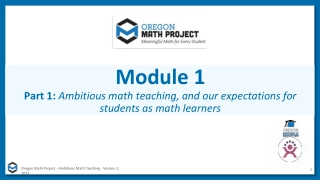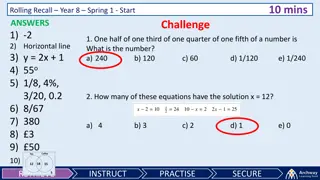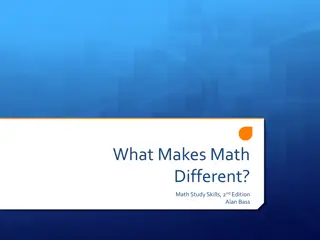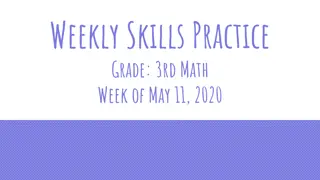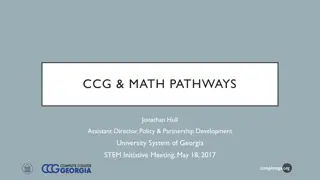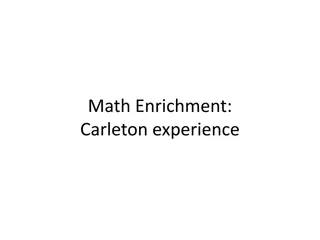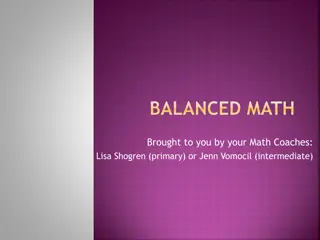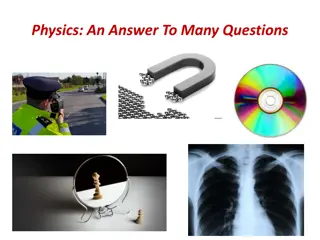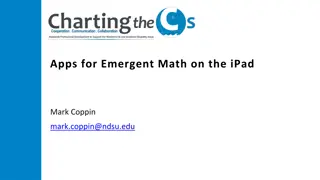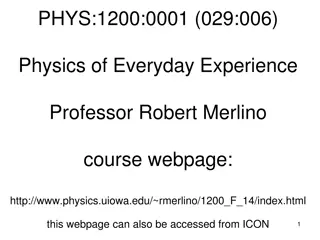Investigating Physics Students' Difficulties with Basic Math Skills
Physics instructors face challenges in assessing students' mathematical skills, particularly in trigonometry, graphing, vectors, and algebra. A study at Arizona State University analyzed 2700 students across 21 physics classes and conducted interviews to uncover prevalent difficulties. Results showed 20%-70% of students struggled with basic trigonometric relationships. The research aims to improve understanding and address these math-related issues in physics education.
Download Presentation

Please find below an Image/Link to download the presentation.
The content on the website is provided AS IS for your information and personal use only. It may not be sold, licensed, or shared on other websites without obtaining consent from the author. Download presentation by click this link. If you encounter any issues during the download, it is possible that the publisher has removed the file from their server.
E N D
Presentation Transcript
Some Mathematical Aspects of Physics Students Problem-Solving Difficulties David E. Meltzer and Dakota H. King Arizona State University Supported in part by NSF DUE #1504986
The Challenge College physics instructors must make certain assumptions regarding their students calculational skills Students problem-solving difficulties can be hard to disentangle from weak skills with basic pre-college mathematics The prevalence and nature of physics students difficulties with basic skills has not previously been investigated systematically
Our Work Examine prevalence and nature of physics students difficulties with trigonometry, graphing, vectors, and algebra Use stripped-down problems with no physics context
Work to Date Administer (and analyze) written diagnostic, given to 2700 students in 21 algebra- and calculus-based physics classes over five semesters at Arizona State University during 2016-2018; calculators are allowed Carry out individual interviews with 75 students enrolled in those or similar courses during same period
Trigonometry Questions with samples of correct student responses
Trigonometry Questions: Representative Data Correct Response Rate, #1-3 combined ASU Polytechnic campus, Spring + Fall average: Algebra-based course, 1st semester, (N = 116): 37% ASU Polytechnic campus, Spring (2-year average): Calculus-based course, 1st semester, (N = 146): 66% ? ?to to ? ?of students confused on basic trigonometry relations of students confused on basic trigonometry relations
Trigonometry Questions: Summary Regardless of course, semester, campus, or question type, between 20% and 70% of introductory physics students at ASU have significant difficulties with basic trigonometric relationships. Students frequently tended to self-correct errors during interviews, suggesting that many of the errors were careless or due to insufficient review or practice.
Physics Students Difficulties with Algebraic Symbols and Operations Extensive investigations by Torigoe and Gladding (2007; 2007; 2011): Probed differences in University of Illinois students responses to physics problems posed in numerical and symbolic form. In general, students tended to have more difficulties with questions in symbolic form. Our investigation at Arizona State probed physics students responses to mathematical problems stripped of all physics context
Students Difficulties with Symbols Confusion of symbolic meaning: Students perform worse on solving problems when symbols are used to represent common physical quantities in equations [Torigoe and Gladding, 2007; 2011) Example [University of Illinois]: Version #1: A car can go from 0 to 60 m/s in 8 s. At what distance d from the start at rest is the car traveling 30 m/s? [93% correct] Version #2:A car can go from 0 to v1 in t1 seconds. At what distance d from the start at rest is the car traveling (v1/2)? [57% correct] Much worse! Our results on stripped-down versions are analogous, although differences are smaller
Algebra: Simultaneous Equations Do differences in students success rate between numerical and symbolic versions of same problem persist when simultaneous equations are involved? (E.g., two equations, two unknowns)
From Torigoe and Gladding (2011): Mg T = Ma TR = I [I = MR2; = a/R] Fnet = ma net = I Mg T = Ma TR = [ MR2][a/R] a = ?
From Torigoe and Gladding (2011): Mg T = Ma TR = I [I = MR2; = a/R] Mg T = Ma TR = [ MR2][a/R] a = ?
From Torigoe and Gladding (2011): Mg T = Ma TR = I [I = MR2; = a/R] Mg T = Ma TR = [ MR2][a/R] a = ? Symbolic version
Results on #10 [Torigoe and Gladding, 2011] Numeric version: 49% correct (N 380) Symbolic version: 53% correct (N 380) No significant difference ( because students are forced to use the same procedure to solve both the numeric and symbolic versions. Torigoe and Gladding, 2011)
From Torigoe and Gladding (2011): Mg T = Ma TR = I [I = MR2; = a/R] Mg T = Ma TR = [ MR2][a/R] a = ? Symbolic version
From Torigoe and Gladding (2011): Mg T = Ma TR = I [I = MR2; = a/R] Rename to simplify: Mg T = Ma TR = [ MR2][a/R] Mg a M b R c MR d T y a x a = ? a y = bx cy = dx x =? Our Symbolic version
From Torigoe and Gladding (2011): Mg T = Ma TR = I [I = MR2; = a/R] Mg T = Ma TR = [ MR2][a/R] a = ? 78.4 y = 8x 0.5y = 2x x =? Our Numeric version
Results on Our Versions Calculus-based course, 1st semester: Numeric version: 87% correct (N = 733) Symbolic version: 63% correct (N = 733) Large and highly significant difference (Because [?] many of the students who can t do the physics, can do the math but only when posed in numerical form)
Other Difficulties with Symbols Possible confusion due merely to replacing numbers by symbols Is this a real difficulty for physics students?
Confusion due to replacing numbers by symbols 5 ? ? ? 3 = ? = ? = ? ? = ? ? ? 10 ? cos? = cos60 = ? = ? ? = ?
Level 0: Confusion due to replacing numbers by symbols What is the value of x? 49% correct 41% correct [First-semester (Fall 2017), calculus-based; N = 91] McNemar Test for Correlated Proportions: p = 0.10 New results, N = 903: 3% difference, p = 0.03
Why the Difficulties with Symbols? Some Suggestions Arising from the Interviews In elementary math courses, simplified forms of equations are emphasized (i.e., few messy symbols and functions). Many students get overloaded by seeing all the variables, and are unable to carry out procedures that they do successfully with numbers. Many students have had insufficient practice with algebraic operations to avoid being overwhelmed by standard algebraic manipulations. Students tend to become careless
Summary: Implications for Instruction Difficulties might be addressed by: short-term, in- and out-of-class tutorials and assignments, designed to refresh students previously learned knowledge and skills (e.g., Mikula and Heckler, 2017) guiding students to (1) explicitly identify known and unknown variables; (2) carefully check and re-check key steps in calculation; (3) slow down, review, and re-solve when possible



